No wonder that apps that allow users to train at home with the same success as in the gym have gained enormous popularity. It’s convenient — you can work out at the time you want and no one will be watching. Of course, COVID-19 also played a big role in the popularity of fitness apps — the gyms were closed. Now gyms are slowly opening up, but some people prefer working out at home. If you are interested in app development, it’s time to learn about developing mobile fitness apps.
Fitness app market
Gyms are slowly opening up, but the popularity of fitness apps is still growing. What is the mobile fitness app market in numbers?- Health and fitness app downloads reached 593 million in the first quarter of 2020.
- Statista says revenue in the fitness app segment will reach $16,596.42 million in 2022.
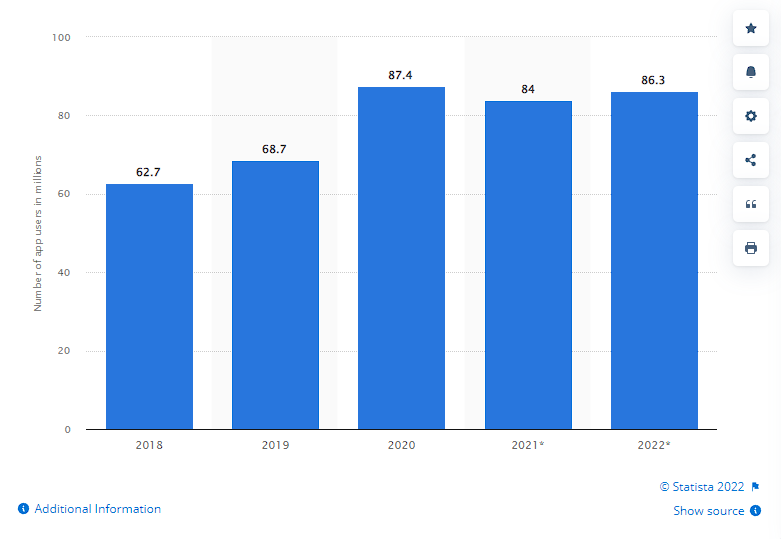 Number of health and fitness app users in the United States from 2018 to 2022 (in millions)
Number of health and fitness app users in the United States from 2018 to 2022 (in millions)
Fitness app types
People do sports for different purposes. Someone wants to get healthier and stronger physically, someone wants to change the parameters of his body — to lose weight or, on the other hand, to gain weight. Some people just like the emotional feeling after a workout and the thought of achieving a certain result — for example, running more kilometers than yesterday. There are different mobile fitness apps for different purposes.When developing a mobile app, the first thing to do is to define its business purpose. What do users need it for? We have compiled a classification of fitness apps according to different purposes.
Workout apps
When you think of fitness apps, the first ones that come to mind are workout apps with exercise programs and instructions. In such apps, you can find programs for increasing physical strength, endurance, etc. The most important thing in such apps is to teach the user to do the exercises correctly, so it is better to add videos on how to do exercises. In these apps, users can get advice from a professional trainer online. These apps usually help users track their progress. To improve the user experience, add the device synchronization feature. An example of a workout app is Apple Fitness Plus.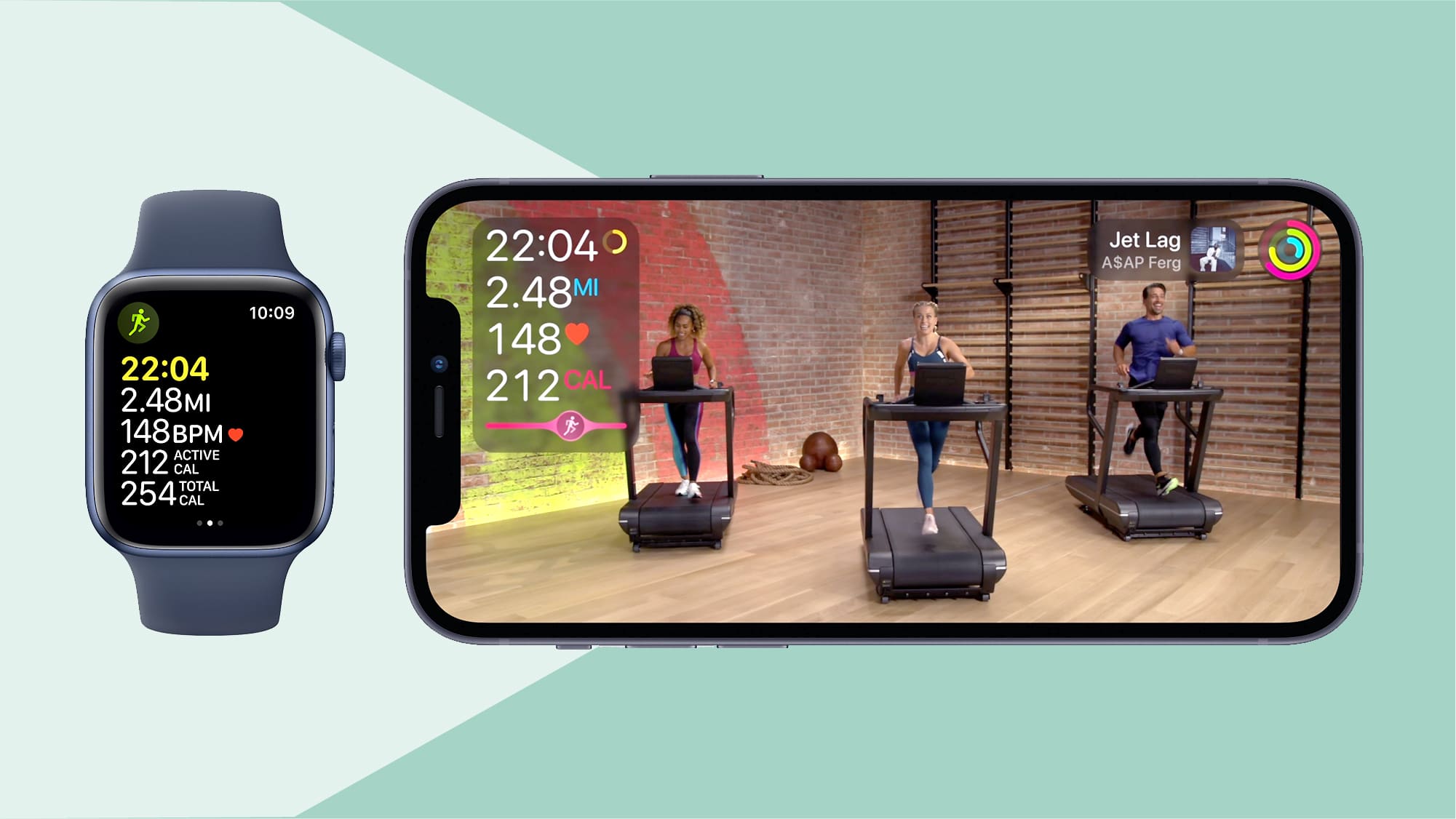
That’s what the Apple Fitness Plus app looks like.
Activity tracking apps
To track users’ progress, fitness apps use GPS to track distance traveled, speed, and altitude. Apps that track physical activity are integrated with wearable devices from which they can get useful information. They can help the user calculate the number of steps taken, their heart rate, and even their stress level! Tracking apps are used not only by professional athletes but also by people who want to track their health indicators. A good example of such an app is Nike Running Club.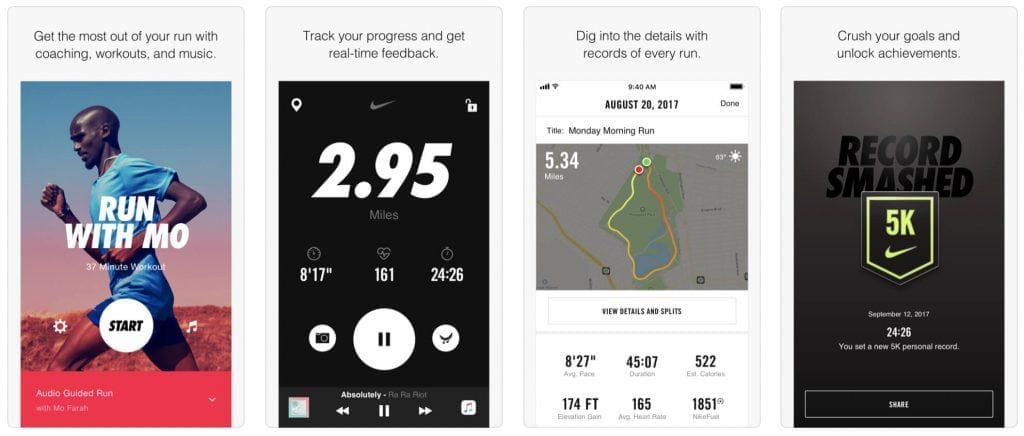
That’s what the Nike Running Club app looks like.
Nutrition apps
What are a healthy lifestyle and constant workout without proper nutrition? Nutrition apps are designed to help users keep track of what they eat. In such apps, one can set goals, for example, to lose or gain weight, check calories, and find recipes for proper nutrition. What is in such apps? Food data tables — information about calories, proteins, fats, and carbohydrates in different foods. A calorie calculator helps to calculate the daily calorie allowance depending on the user’s physique: age, gender, height-to-weight ratio, and food diaries to make it easier for users to keep track of what they eat. An example of such an app is MyFitnessPal.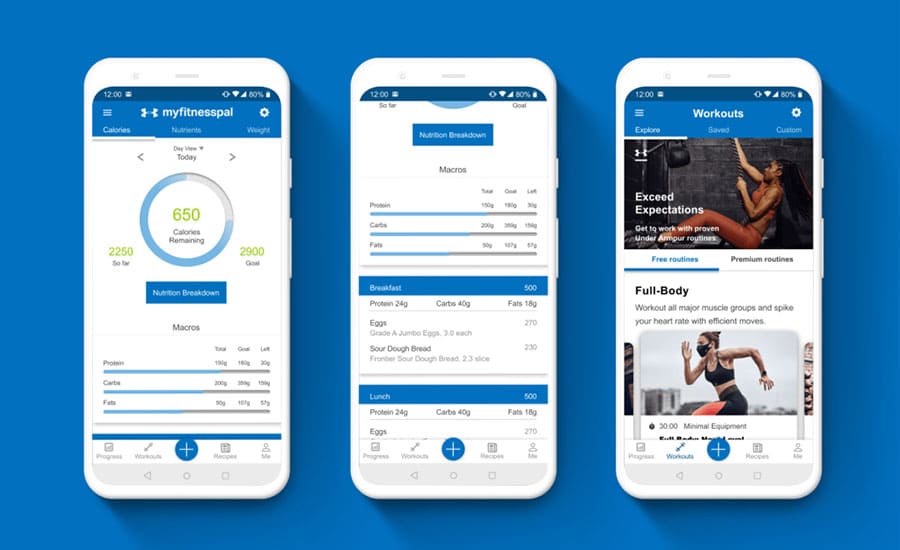
That’s what the MyFitnessPal app looks like.
Fitness club apps
These are apps tied to a specific fitness club. As a rule, the purpose of such applications is marketing. It is convenient for users to sign up for workouts and keep track of their schedule through such an app. Some clubs add to their apps the function of communicating with a trainer. This was especially relevant during the pandemic when gyms were closed. Through such apps, users could connect with their trainers for workouts at home. An example of such an app is McFit.Yes, fitness apps don’t just show you how to do exercises — they offer much more. The demand for fitness apps is so high that there are dozens of different apps for each type. There are also apps that combine several types of fitness apps. Have you heard of Centr Fit by known actor Chris Hemsworth? This app combines workouts and meal plans. It’s definitely a win-win if you want to build a fitness app because you can reach more audiences. Now that you have an understanding of the fitness app market, it’s time to talk about how to develop them.
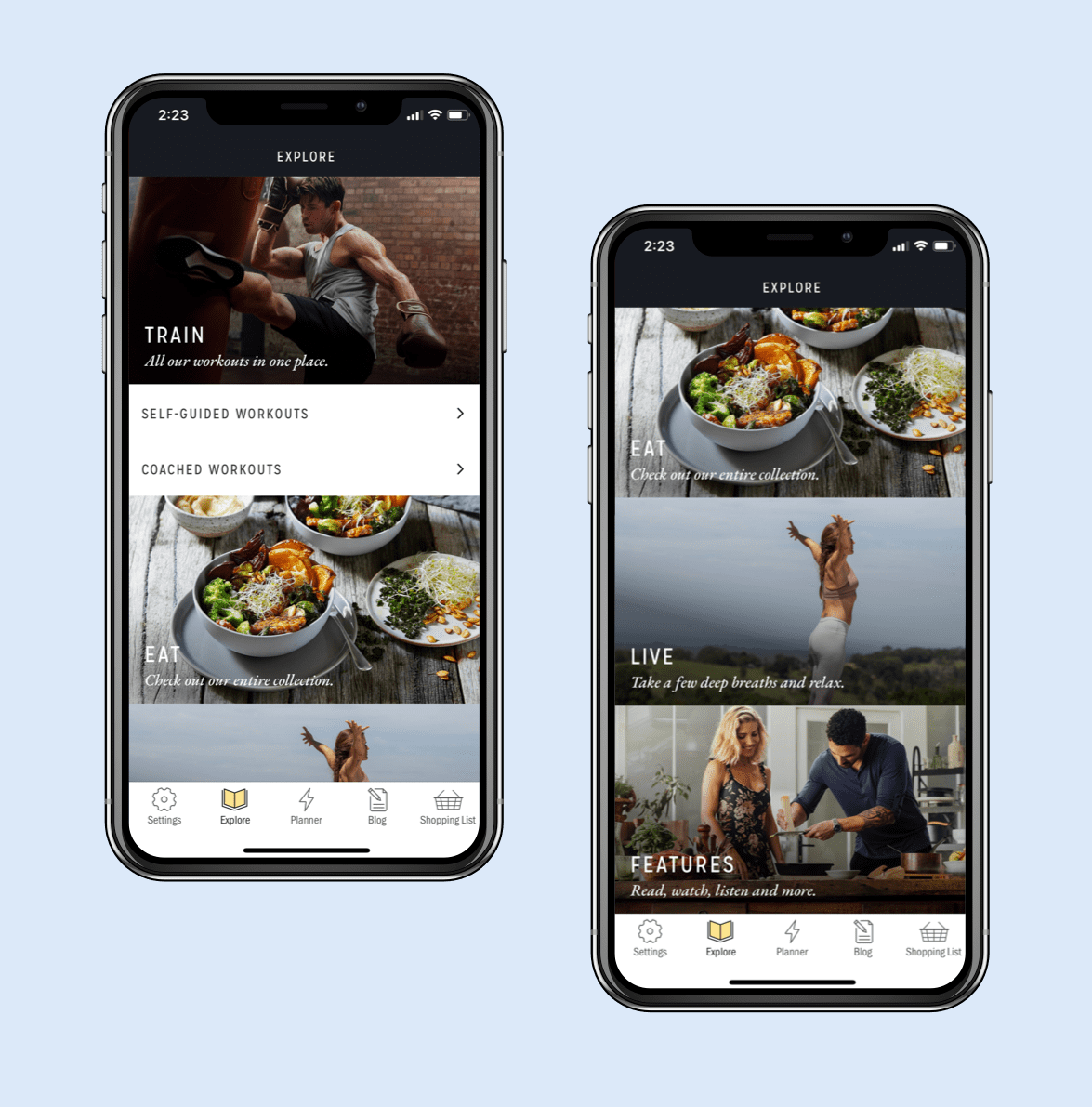
That’s what the Centr Fit app looks like.
How to build a fitness app: core features
To create your own fitness app, you need to think about its functions. Of course, all fitness apps have different features depending on the type, but there are some features that no app can be without. Here is a list of the most important functions for training apps in our opinion.✔️ Profile
Definitely a must-have! It should be easy for the users to keep track of their physical metrics and achievements in their profiles. And without a profile, the user will just study and not see any progress in the app. Keep in mind that different countries use different units of measurement (pounds, kilograms, etc.). This is important because, for example, the US does not use the metric system, but if you want to reach a larger market, you need to add metrics for other countries as well.Some fitness apps have two versions: one for clients and one for trainers who can register in the app and post their workouts there. Make sure you provide a great user experience for both sides.
✔️ Training
When you’re designing an app, we recommend you make your workout menus minimalistic and intuitive. Add clear exercise schemes and quality videos and a success chart to keep track of your progress. This feature allows users to combine exercises and create their own workout programs or provide a set of standard ones.✔️ Geolocation
Geolocation allows users to create routes for walking, running, or biking, track their current position and record walked or jogged distance. This way, the users can visually assess the route they have passed. In the end, the user will receive data about their speed, the distance they passed, how much time it took, and the number of burned calories if necessary.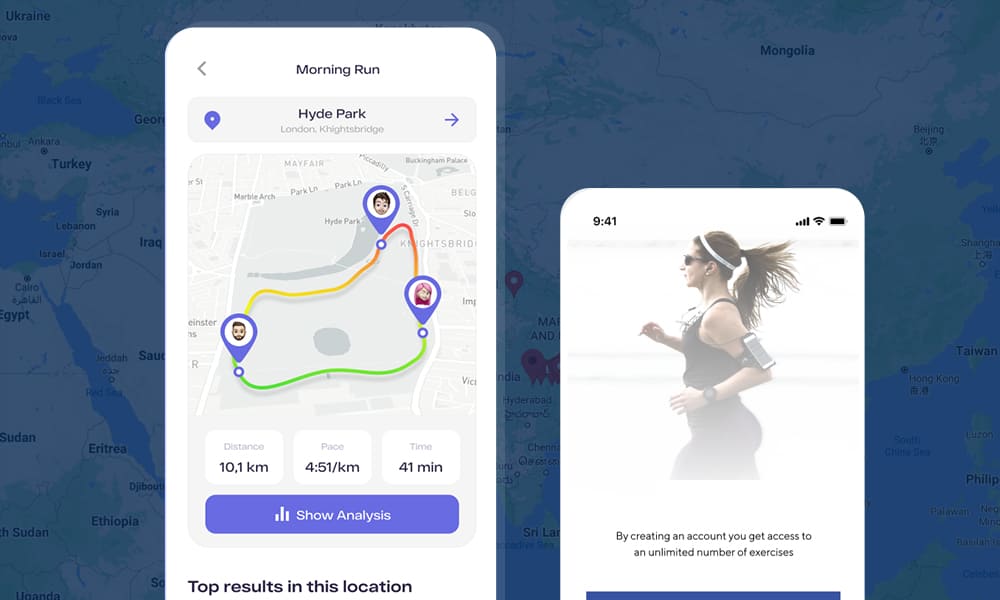 An example of the geolocation feature in a fitness app.
An example of the geolocation feature in a fitness app.
✔️ Goal setting
To make it easier for users to gauge their success, you should add the ability to track progress and set goals. The user will be happy to see a congratulation on the screen that they have achieved their goal. People download fitness apps to become a better version of themselves, and you need to encourage them. Add an achievement system based on users’ results and give them virtual or real prizes. This will help with the marketing strategy of your fitness app — you can find advertisers willing to act as partners.✔️ Gamification
Sports go hand in hand with competition. The user will like it if he can compete with his friends or other users in the application. To achieve certain results, the user receives points and passes to the “higher league” and they already compete with representatives of this league. Progress indicators and leaderboards are powerful generators of motivation + increases user engagement in the app.This is how Nike turned an ordinary run into a real quest. Their running app allows you to count the number of calories burned and track your heart rate, mileage, and other characteristics. They added a competitive element to the whole thing — users competed for the status of the best runner. So the company increased customers’ motivation to exercise and use the app.
An extra point to the gamification story is the social media sharing feature. Give users the opportunity to share their success on Instagram or Twitter and they’ll love it!
✔️ Notifications
There are many examples of notifications and reminders in fitness apps: when it’s time to start a workout, switch to another exercise, or stop a routine. People are not robots and they can lose motivation to exercise. Pleasant UX copywriting in alerts will help them to remember about workouts and the emotions from the training they got.Users should be able to customize the frequency and timing of notifications according to their personal preferences. If they get notifications about everything, it will be annoying, and if they can’t turn off some of the notifications, they will probably just download another app that is not annoyed by constant reminders.
✔️ Wearable devices integration
Many people who train have gadgets like the Apple Watch or Xiaomi Mi Band, and they prefer to use applications that have synchronization with these devices. Such devices help to track metrics and physical indicators more accurately. With them, users know how many kilometers they ran or what is their heart rate. Statistical data will help the user adjust the training process to their abilities. And if you create an app just for smart devices, users can not take their phone for a workout and use the same functionality of the phone’s app on their SmartWatch.✔️ Chat
The ability to share results will motivate users to grow. Users chat with friends and discuss their achievements. Under the “gunpoint” of friends, the user won’t want to quit working out and will want to share their progress more.Development stages of making a fitness app
At the beginning of the fitness mobile app development process, the primary task will be to formulate the concept of the project. What tasks will your app solve? What audience will your app be designed for? What unique features will your app have? Market research will help to answer these questions. Look at the App Store and Google Play reviews for other apps in your niche in order to be better than your competitors. What users miss in other apps will become an adjustment in yours.After market research, come the stages of directly developing and releasing the app:
- Project Management
- UI/UX design
- Front-end development
- Back-end development
- Testing
- Release
Any custom software development requires proper planning in terms of budget. At Brivian, the approximate app development services timeline and the cost are 2 months and $30,000 to develop a cross-platform fitness app and 4 months and $45,000 for developing a native fitness app.
❗️ P.S. Please note that this estimate is based on limited information. Different projects involve different levels of design complexity and different amount of functionality. You can get an accurate estimate of your project by contacting our managers.
Brivian’s expertise in the fitness niche
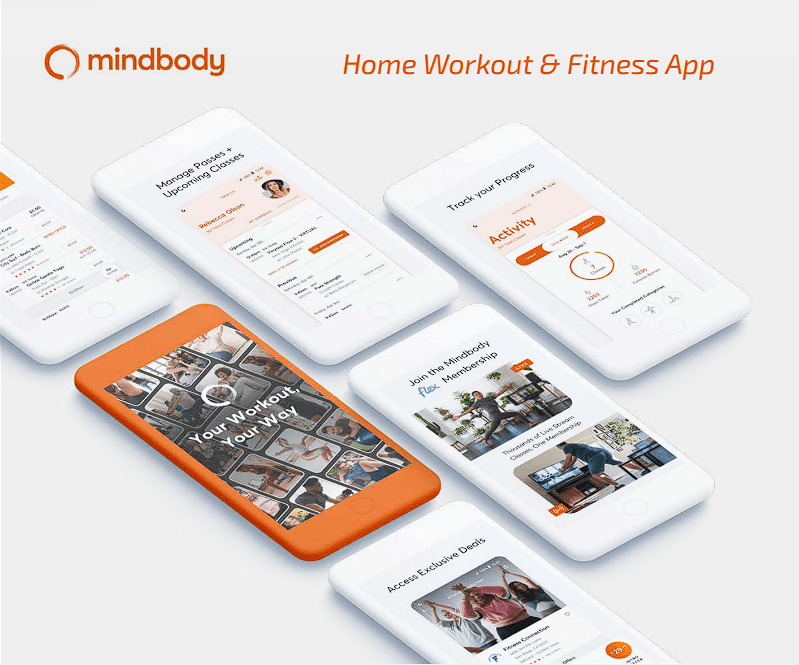
This is one of our latest projects, the Mindbody fitness app.
One of Brivian’s latest Brivian projects was the home workout and fitness app Mindbody. We made an assistant that helps users to work out and become more confident in their bodies. We added workout options for beginners and for those who want to set personal records. Also, we added integration with Google Fit to access stats on classes, appointments, and enrollments quickly.Top fitness apps for aspiration
We decided to tell you about some of the most popular apps in the fitness niche and what features attract millions of users every day. Maybe you’d like to add some of these to your app, too!🔴 Freeletics. Considered being the best app for high-functioning, intensive workouts. The focus of the app is on bodyweight exercises such as burpees, squats, and sit-up variations, which are easy to perform anywhere and anytime. When users activate the paid mode, an AI trainer becomes available and helps them tailor workouts individually. Convenient for both beginners and professional athletes.
🔴 Strava. An app for those who value a sense of community and social connection. It is designed for those who play sports and enjoy small friendly competitions as they run, bike and swim. Users can compete with their friends, or with themselves, by comparing current results with results from the past. The app gives extensive performance metrics so the users can better analyze their progress.
🔴 Map My Run. One of the first and best running apps. Users appreciate it for its database of more than 70 million running routes. The app records distance, pace, altitude, calories burned, and more while running. Users also have access to real-time audio workouts during runs tracked by GPS.
A few words about building a fitness app
Once you’ve come up with an idea for a fitness app, you have two options: either plan and create a fitness app yourself or hire an app development services company that will do everything for you.When it comes to creating digital products from scratch, it makes sense to create a minimum-viable product first. In this case, you only develop basic functionality to get to market faster and test the idea. When the app will be released and acquire its first users, it will be clear to you whether your product is useful for customers and how you can improve it in the future.
If you are not yet sure what kind of app you want, you can request a consultation and our manager will help you determine the type of your app, choose a business model and work out a monetization strategy. Or if you know exactly what application you want and know your business goals, you can also apply to us for the development of a mobile application. You can fill in the form here.